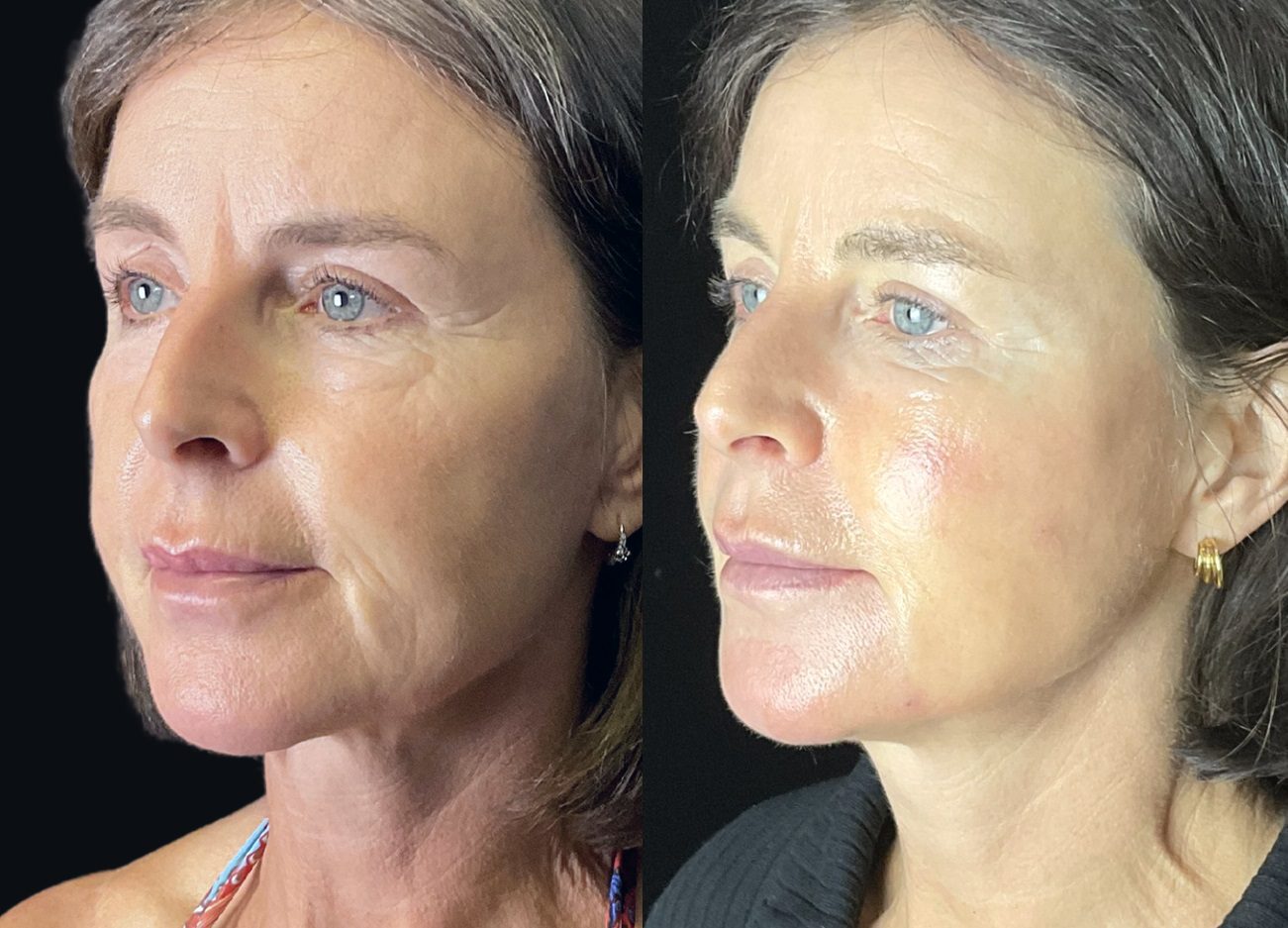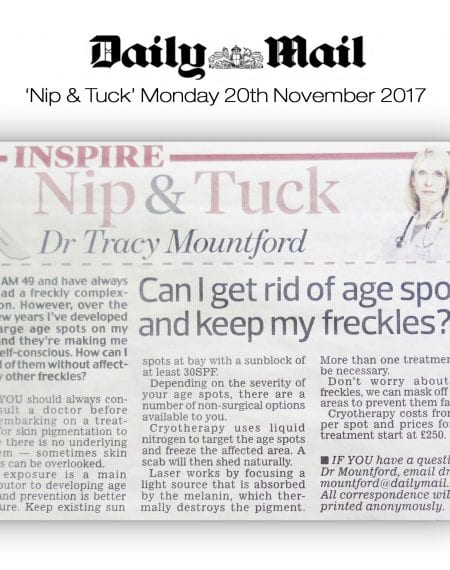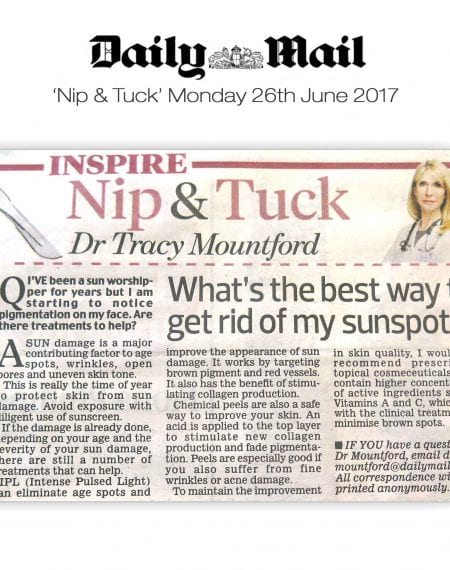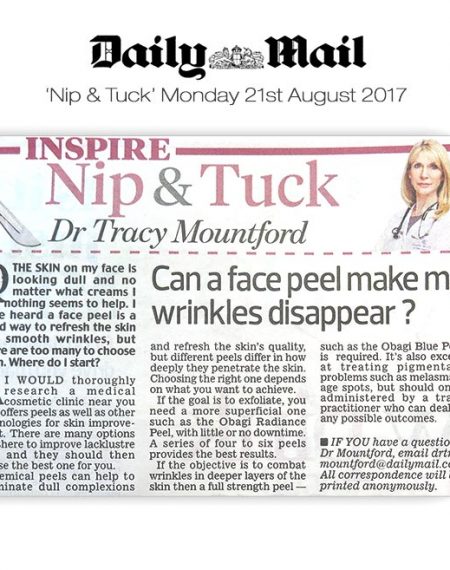Summary of Content
Click on the links below to jump to each section:
- What is Photodamage?
- What are the signs of Photodamage?
- Who is at risk for Photodamage and can it be treated?
- How will I know which treatment is right for me?
Q1 – What Is Photodamage?
Photodamage, also known as sun-damaged skin, is something most of us experience to some degree. Whether you actively sunbathe or not, daily exposure to UV (ultraviolet) radiation gradually takes its toll. In fact, UV exposure is the number one cause of skin ageing and is responsible for around 90% of premature ageing signs. Surprisingly, up to 25% of our lifetime sun exposure happens before we even reach our teenage years.
Over time, UV rays break down collagen fibres and reduce the skin’s natural ability to repair itself. This leads to a loss of elasticity, which can show up as fine lines and wrinkles, especially around the eyes, mouth, and forehead. Other common signs include thinning lips, uneven texture, and crepey or lined skin on the neck, chest, arms and legs.
There are three types of photodamage:
- Epidermal photodamage affects the skin’s surface layer.
- Dermal photodamage occurs deeper within the skin.
- Combination photodamage impacts both layers and can appear as uneven pigmentation or melasma.
At The Cosmetic Skin Clinic, we understand how photodamage affects skin confidence. The good news is that with the right treatments and expert care, we can target sun damage at every level, helping to restore healthier, brighter, and more youthful-looking skin.
Q2 – What are the signs of Photodamage?
Photodamage presents differently in every individual, but it most commonly appears on areas of the skin that receive the most sun exposure—especially the face. Over time, daily UV exposure can lead to visible changes such as fine lines, pigmentation, and uneven skin texture.
Most individuals with photodamage exhibit some or all of the following signs:
- Abnormal skin texture, including pebbling
- Deep or excessive wrinkles
- Large amounts of freckles or other discoloration (hyperpigmentation)
- Liver spots
- Skin inelasticity, sagging
- Permanent skin darkening and melasma
- Redness and inflammation
- Visible blood vessels (telangiectasia)
Q3 – Who is at risk for Photodamage and can it be treated?
Photodamage is primarily caused by prolonged exposure to ultraviolet (UV) rays, which gradually break down the skin’s structural support and accelerate the ageing process.
The most effective treatment for photodamage is prevention. Daily use of a broad-spectrum sunscreen is essential – opt for SPF 30-50 in winter, and SPF 50 or higher during the summer months. In addition to sunscreen, protective clothing such as wide-brimmed hats and UV-resistant garments can help shield the skin from further damage. During peak sunlight hours, it’s also best to limit or avoid direct sun exposure altogether.
While photodamage may not always be completely reversible, a range of advanced aesthetic treatments can significantly improve the appearance of sun-damaged skin. At The Cosmetic Skin Clinic, we offer tailored treatment plans designed to target pigmentation, fine lines, skin laxity, and uneven tone, helping to restore healthier, more radiant skin.
Q4 – How will I know which treatment is right for me?

There are various treatments available to reduce the appearance of photodamage and help prevent the development of further damage. These include:
- Chemical peels, which remove damaged skin and improve the health of new skin
- Hyaluronic acid fillers which stimulate new collagen
- Muscle relaxants primarily for the upper face
- Laser resurfacing, which uses laser light to repair some of the UV light damage
- Polynucleotides, which stimulate collagen and elastin production in the skin’s cells
- Tixel, with ablative and non-ablative settings, we can tailor the treatment to the individual patient without the downtime and side effects associated with that of regular lasers.
- Topical retinol based products
At your initial consultation with our qualified medical practitioners, your skin will be assessed and we will discuss a personalised treatment plan that’s tailored to you. Investing time and effort in your skin health is worthwhile.
How to find our clinics?
The Cosmetic Skin Clinic in London
The Cosmetic Skin Clinic in London is located in Harley Street and within walking distance of Baker Street, Oxford Circus and Bond Street tube stations. We’re also conveniently located and just a quick train ride away from Paddington or Kings Cross St Pancras Train Stations.
The Cosmetic Skin Clinic in Buckinghamshire
The Cosmetic Skin Clinic in Buckinghamshire is situated in Stoke Poges and near Gerrards Cross (Chiltern Railway) and Slough’s (First Great Western) station. If you’re travelling by car, the M25, M4, M40 and A40 roads, makes it very convenient to reach from Kingston upon Thames, Wembley, Richmond, and from the Surrey area.
The Cosmetic Skin Clinic in Bournemouth
The Cosmetic Skin Clinic Bournemouth is situated in the centre of Bournemouth, the golden strand of the South Coast. Our Bournemouth location is a stone’s throw away from award-winning beaches and a short drive from luxurious Sandbanks, home to ‘Millionaires Row’.
The Cosmetic Skin Clinic in Northampton
The Cosmetic Skin Clinic Northampton is situated in a charming period building called The Gatehouse within St Andrew’s Hospital grounds on the outskirts of Northampton city centre where we are co-located with our surgical sister clinic – The Private Clinic, providing a peaceful and discreet setting for your skin treatment or consultation.
The Cosmetic Skin Clinic in Lymington
The Cosmetic Skin Clinic Lymington can be found in a beautiful mews on Gosport Street, Lymington.
The Cosmetic Skin Clinic in Kent
The Cosmetic Skin Clinic Kent is located within Barham Court, a beautiful English country house in the village of Teston, Maidstone.
For more details about our clinic’s locations and the best way to reach us based on your means of transportation, please take a look at our dedicated clinic location pages.























